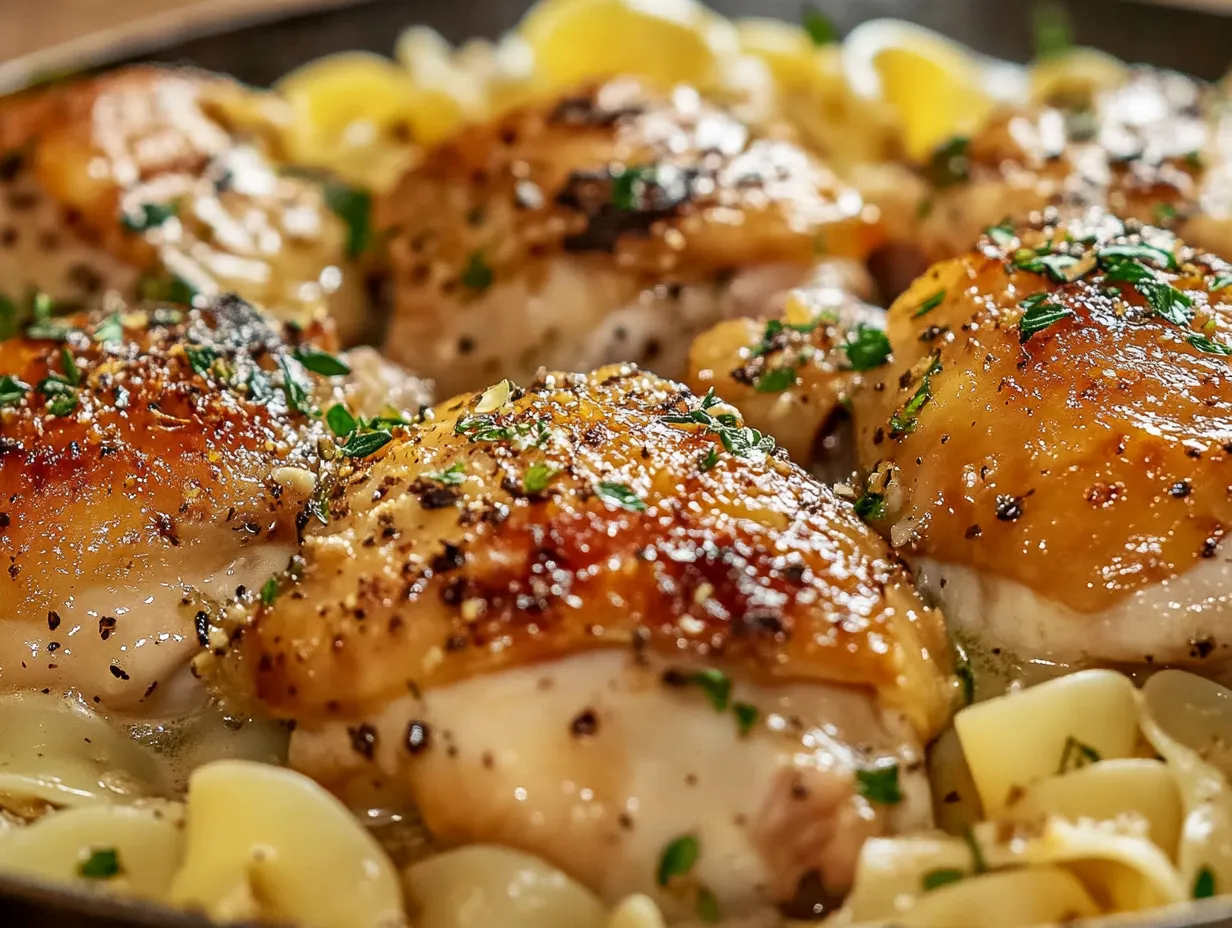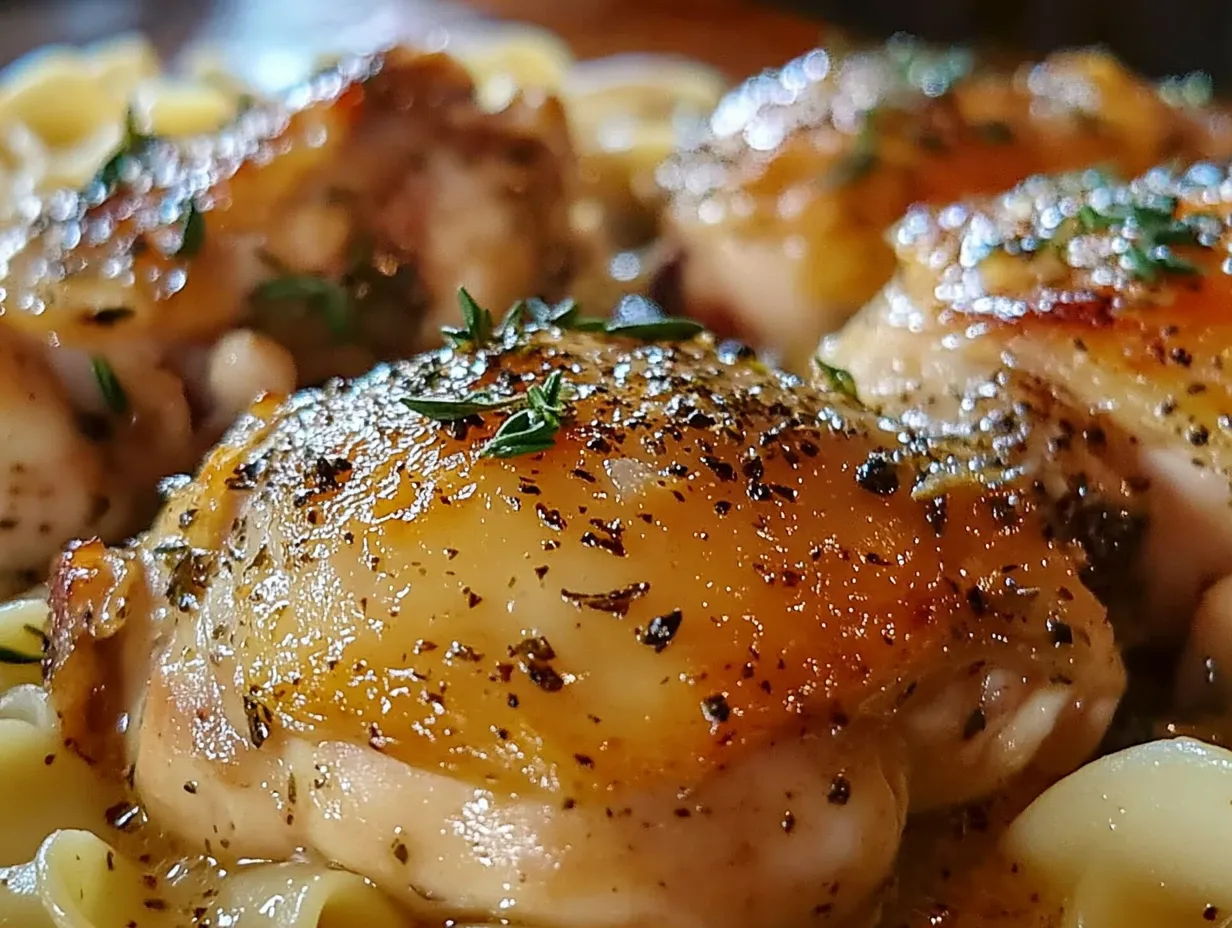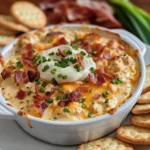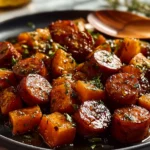Amish cuisine holds a special place in the heart of American comfort food, celebrated for its simplicity, traditional flavors, and hearty servings. Rooted in the values and lifestyle of the Amish community, this culinary style focuses on wholesome ingredients and straightforward preparation methods. Recipes are often passed down through generations, emphasizing sustenance and taste over complex cooking techniques or elaborate ingredients. Amish dishes bring warmth and nostalgia to the table, reflecting the community’s connection to the land and its produce.
The Amish Chicken Recipe exemplifies this appeal, offering a delightful combination of rich, creamy flavor and tender, juicy chicken that’s easy to prepare. Known for its simple ingredients and minimal fuss, this recipe bakes the chicken to perfection in a creamy gravy that blends seasonings with a hint of garlic and paprika. It’s a satisfying dish ideal for family meals, gatherings, or whenever you’re in need of comfort food that’s both easy to prepare and sure to impress. Each bite brings together savory spices, a velvety sauce, and tender chicken, making Amish chicken a staple for those who appreciate the timeless appeal of homemade, traditional flavors.
What Makes Amish Chicken Special?
The Amish Chicken Recipe stands out due to its use of simple, high-quality ingredients and an effortless baking method that produces a luxurious result. Unlike more complex recipes, it doesn’t require marinating or advanced techniques—yet the flavors are full and comforting. The use of heavy cream mixed with water creates a rich, creamy base, which thickens as it bakes to form a savory gravy coating each piece of chicken. Seasoned with garlic powder and paprika, the flavor is mild but savory, enhanced by a hint of pepper and salt that perfectly complements the natural taste of the chicken.
This recipe’s magic lies in the balance of creamy and mildly spicy elements, creating a dish that’s both heartwarming and satisfying. The slow-baking process ensures the chicken remains juicy and tender, while the gravy bubbles into a golden crust, adding a lovely texture and color to the finished meal.
Ingredients Overview
A key to success with Amish chicken lies in understanding the purpose of each ingredient and choosing the best quality available. Here’s a closer look at the essential components:
- Chicken: The recipe is versatile, allowing you to use thighs, drumsticks, or breasts. Dark meat like thighs and drumsticks brings richer flavor and tends to stay juicier during the long baking process, but chicken breasts work well too if preferred. Each cut contributes a different texture, so you can choose based on your personal taste.
- All-Purpose Flour: Flour plays a dual role in this dish. First, it coats the chicken, creating a lightly crisped exterior that absorbs the creamy gravy. Second, it acts as a thickening agent for the gravy, ensuring it achieves a satisfying, rich consistency as it bakes. For those with gluten sensitivity, cornstarch can serve as a substitute, although the texture may vary slightly.
- Seasonings: Garlic powder, salt, black pepper, and paprika combine to form a flavorful, balanced seasoning that’s subtle but impactful. Garlic adds depth, paprika offers a mild smokiness and color, and pepper adds a hint of spice. Adjust the seasoning amounts to suit your palate if desired.
- Heavy Whipping Cream and Water: This mixture is the creamy foundation of the dish. The cream lends a rich, smooth consistency, while water lightens it just enough for perfect pouring and baking. Together, they create a silky, savory gravy that thickens beautifully over the chicken as it bakes. For a lighter version, half-and-half or milk can be used, though the texture will be less rich.
When possible, opt for organic or pasture-raised chicken and high-quality spices, as these ingredients will elevate the traditional flavors and bring authenticity to this comforting dish.
Step-by-Step Recipe Instructions
Preparing the Chicken
To start, clean the chicken thoroughly under cold water to remove any excess fat or impurities. Once cleaned, place each piece on a clean towel or paper towel and pat dry. This step is crucial, as drying the chicken ensures that the flour mixture adheres evenly, creating a consistent coating. Patting the chicken dry also helps achieve a crispier finish, as excess moisture can prevent the coating from setting properly.
Select your preferred cuts, such as thighs, drumsticks, or breasts, depending on taste and desired texture. Thighs and drumsticks add a rich flavor and stay moist during baking, while chicken breasts provide a leaner option. Regardless of the cut, ensure each piece is similar in size for even cooking. For extra flavor, you may also consider lightly scoring the skin of each piece with shallow cuts. This allows the seasoning to penetrate deeper and enhances the overall taste.
Seasoning and Coating Process
To create the seasoning mixture, combine the all-purpose flour, garlic powder, salt, black pepper, and paprika in a shallow bowl. Mix thoroughly, as evenly distributed seasonings ensure each chicken piece receives the full depth of flavor. This seasoned flour coating provides a mild, savory taste that perfectly complements the creamy sauce in the baking process.
Once the flour mixture is ready, dredge each chicken piece in the seasoned flour, making sure it is well-coated on all sides. Press gently to allow the flour mixture to adhere, then shake off any excess. This light coating will form a crisp exterior that absorbs the cream mixture as it bakes, locking in the moisture and creating a savory crust.
Handle the chicken gently to avoid losing the coating during transfer, and if working in batches, make sure each piece has enough space for even coverage. Avoid overcrowding the dredging area, as this may cause the flour mixture to clump.
Preparing the Baking Dish
A well-prepared baking dish ensures the chicken bakes evenly and develops a lovely, golden-brown finish. Lightly grease the baking dish with a small amount of butter or oil, coating the bottom and sides to prevent sticking. This step also contributes to the overall crispiness of the dish as it bakes.
Next, sprinkle a small amount of the seasoned flour mixture over the greased dish. This layer acts as a subtle base that enhances the texture of the gravy and prevents the chicken from sticking. The flour also helps create a slightly thickened layer beneath the chicken, which absorbs some of the cream mixture and adds an extra touch of flavor to each serving. Arrange the chicken pieces in the dish, skin side up, ensuring they are evenly spaced for optimal cooking.
Making the Cream Mixture
In a medium-sized bowl, combine the heavy whipping cream and water, stirring until fully blended. The mixture should be smooth and slightly diluted to a pourable consistency, striking a balance between creamy richness and a lighter texture. This combination of cream and water forms the base of the gravy, which will cook down and thicken as the chicken bakes, giving it a rich flavor.
Carefully pour the cream mixture over the chicken, ensuring that each piece is evenly covered. For a well-blended gravy, pour slowly and allow the mixture to settle around the chicken. This ensures the cream mixture evenly coats the seasoned flour on each piece, helping it develop a creamy, thick sauce as it bakes. Avoid stirring or disrupting the seasoned flour on the chicken once the cream mixture is added, as this helps maintain the integrity of the coating.
If you prefer a thicker sauce, you can slightly reduce the water or increase the cream to add more richness.
Baking Process
Preheat your oven to 350°F (175°C) to ensure even cooking. A well-preheated oven allows the chicken to cook through without becoming dry while giving the cream mixture time to thicken into a golden-brown gravy.
Place the baking dish in the oven, and bake for approximately 1 1/2 hours. This time allows the chicken to become tender and juicy, while the cream mixture reduces to a thick, bubbling gravy. For a deeper golden color and enhanced flavor, avoid covering the dish with foil, as this encourages the top to caramelize slightly. Depending on the size and thickness of the chicken pieces, the baking time may need slight adjustments. For larger cuts, you may need an additional 15–20 minutes to ensure the internal temperature reaches a safe 165°F (74°C).
As the chicken bakes, monitor the progress by checking the color and consistency of the gravy. It should be thick, bubbling, and golden brown, with a crisp surface forming on the top. The chicken itself should appear tender, with the juices running clear. If using a thermometer, insert it into the thickest part of the chicken without touching the bone to confirm doneness.
Once the chicken is fully cooked, remove the baking dish from the oven and allow it to rest for 5–10 minutes before serving. This rest period allows the gravy to thicken slightly, enhancing the dish’s flavor and making it easier to serve.
Serving Suggestions
After allowing the chicken to rest, serve each piece with a generous spoonful of the creamy gravy. The gravy’s savory, mildly seasoned taste pairs well with a variety of classic side dishes, creating a complete and comforting meal. Consider serving Amish chicken with buttery mashed potatoes, which soak up the gravy beautifully. Steamed or buttered green beans make a perfect vegetable accompaniment, balancing the richness of the chicken with a fresh, crisp element.
For a truly authentic experience, serve with slices of Amish-style bread, ideal for dipping in the creamy sauce. This recipe also pairs well with roasted vegetables, cornbread, or even a simple salad, allowing you to tailor the meal to your preference.
Variations of Amish Chicken Recipe
While the traditional Amish chicken recipe is delicious as is, there are several ways to adapt it to suit different preferences and dietary needs:
- Herb Additions: Add fresh rosemary, thyme, or sage to the cream mixture for a more aromatic flavor profile. Herbs like parsley or chives can also be sprinkled over the top before baking.
- Different Cuts: Experiment with boneless, skinless chicken breasts or even whole chicken legs for variation. Bone-in cuts add flavor, while boneless cuts are faster to cook.
- Gluten-Free Option: Substitute the all-purpose flour with a gluten-free blend or cornstarch to make the recipe suitable for gluten-sensitive guests.
- Lower-Fat Alternative: Use half-and-half or whole milk instead of heavy cream to reduce the fat content. While the texture will be slightly lighter, the flavor remains rich and satisfying.
These adaptations offer flexibility without compromising the recipe’s comforting and flavorful essence.
Additional Sections
Tips and Tricks for Perfect Amish Chicken
To achieve the best results with Amish chicken, focus on a few key techniques. For a thick, flavorful gravy, ensure that the flour coating on the chicken is evenly distributed, as it helps the gravy thicken naturally as it bakes. If you prefer an extra-thick gravy, use slightly less water in the cream mixture or add a small amount of cornstarch for added richness.
Avoid overcooking by monitoring the chicken as it bakes, especially during the last 20 minutes. The chicken should reach an internal temperature of 165°F (74°C) for safe consumption. To create a crispy top, leave the baking dish uncovered during the baking process, which encourages browning and allows the gravy to form a golden crust. If the top needs more browning, you can broil the dish briefly at the end, keeping a close eye to prevent burning.
Health and Nutritional Benefits
Amish chicken offers several nutritional benefits that make it both satisfying and nourishing. Chicken is an excellent source of lean protein, supporting muscle health and keeping you fuller for longer. Additionally, the use of heavy cream provides calcium, essential for bone health, and fat, which adds richness to the dish. Seasonings like garlic powder, black pepper, and paprika enhance the flavor without adding unnecessary calories, making the dish flavorful yet balanced.
To make this recipe lighter, consider using half-and-half or whole milk instead of heavy cream for a lower-fat version. Opt for skinless chicken if you prefer a leaner protein, as it reduces the overall fat content without compromising flavor. For those watching their carbohydrate intake, a gluten-free flour or cornstarch alternative will allow you to enjoy the gravy while keeping the dish gluten-friendly.
Conclusion
The Amish Chicken Recipe is a comforting, flavorful dish that embodies the warmth and simplicity of Amish cooking. With its creamy, savory gravy and tender, juicy chicken, it’s a crowd-pleaser that’s perfect for family meals or cozy gatherings. Easy to prepare and flexible for various dietary needs, this dish brings traditional flavors to the table, making it a staple recipe for those who enjoy home-cooked comfort food. Give this Amish chicken a try and savor the authentic taste and heartwarming satisfaction that has made this dish a beloved classic for generations.
FAQs Section
Can I make Amish chicken without heavy cream?
Yes, you can make Amish chicken without heavy cream by using alternatives that still provide a creamy texture. For a similar consistency, use whole milk combined with a few tablespoons of melted butter to add richness. Alternatively, a mix of milk and sour cream can work well, giving a tangier flavor that complements the chicken. If you prefer a lighter option, half-and-half is another good substitute, though the gravy may be slightly thinner.
How long should I bake Amish chicken to ensure it’s cooked?
Bake Amish chicken at 350°F (175°C) for approximately 1 1/2 hours. This time allows the chicken to cook thoroughly while the gravy thickens and turns golden brown. For optimal doneness, the internal temperature of the chicken should reach 165°F (74°C). If you’re using larger pieces or bone-in cuts, you may need an additional 10–15 minutes. For boneless cuts, start checking around 1 hour.
What sides go best with Amish chicken?
Classic sides that pair well with Amish chicken include mashed potatoes, which soak up the creamy gravy beautifully, buttered green beans for a crisp contrast, and homemade Amish-style bread for dipping. Roasted or steamed vegetables, like carrots or peas, also complement the dish nicely. For a more traditional Amish spread, consider pairing it with a side of coleslaw or baked corn pudding.
Can I use skinless chicken for this recipe?
Yes, skinless chicken can be used for this recipe. However, keep in mind that the skin adds both moisture and flavor. Without it, the chicken may cook slightly faster, so check for doneness sooner to avoid drying out. If using skinless chicken, basting with a little extra cream mixture halfway through baking can help retain moisture and richness in the gravy.
How do I store leftover Amish chicken?
To store leftover Amish chicken, allow it to cool completely before placing it in an airtight container. Refrigerate for up to 3 days. When reheating, place the chicken and gravy in a covered baking dish and warm in the oven at 300°F (150°C) until heated through. Adding a small splash of cream or milk can help restore the gravy’s texture if it has thickened too much in the refrigerator.
Print
Amish Chicken
- Author: Munil
Description
This Amish Chicken recipe is simple yet flavorful, featuring tender chicken pieces baked in a creamy gravy. Perfect for a cozy family dinner, this dish pairs beautifully with mashed potatoes, rice, or warm biscuits.
Ingredients
- 6–8 pieces of chicken (thighs, drumsticks, or breasts), cleaned
- 1 cup all-purpose flour
- 2 tsp garlic powder
- 1 tbsp salt
- 1 tsp black pepper
- 2 tsp paprika
- 1 1/2 cups heavy whipping cream
- 1 1/2 cups water
Instructions
1️⃣ Season and Coat the Chicken: In a shallow bowl, combine the flour, garlic powder, salt, black pepper, and paprika. Dredge each piece of chicken in the seasoned flour mixture, shaking off any excess.
2️⃣ Prepare the Baking Dish: Lightly grease a baking dish with butter or oil, then sprinkle a bit of the seasoned flour over the bottom of the dish. Arrange the chicken pieces in the dish, skin side up.
3️⃣ Mix the Cream and Water: In a bowl, stir together the heavy whipping cream and water until well combined. Pour this mixture over the chicken, ensuring each piece is covered.
4️⃣ Bake the Chicken: Preheat your oven to 350°F (175°C). Bake for 1 1/2 hours, or until the chicken is golden brown and fully cooked, and the gravy is thick and bubbling.
5️⃣ Serve: Let the chicken rest for a few minutes before serving. Serve with the creamy gravy alongside your favorite sides.
Notes
- Flavor Tip: Adding fresh herbs like rosemary or thyme to the cream mixture can enhance the flavor.
- Storage: Leftovers can be stored in an airtight container in the refrigerator for up to 3 days. Reheat in the oven for best results.





